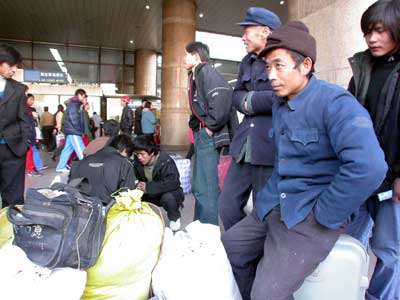|
Limiting in-flow of migrants unnecessary
(Shanghai Daily)
Updated: 2005-11-08 09:16
There are better ways to control Shanghai's growing migrant population
than setting quotas on the number of people allowed to move to the city from
rural parts of China, a symposium on Shanghai's development heard yesterday.
The city of Shanghai could move labor-intensive industries to other
provinces, transfer commercial and residential areas to the suburbs, and reduce
the wealth gab between Shanghai and neighboring regions, delegates to the
symposium said.

Migrant workers
await trains outside a trian station. They leave for cities in the hope to
gain a better life. [newsphoto] |
They were
reacting to comments that Zhang Weiying, a member of Chinese People's Political
Consultative Conference in Beijing, made earlier this year, suggesting the
capital should limit domestic immigration.
It doesn't make sense to restrict the in-flow of migrant workers for the sake
of local development, when more effective and humane steps can control the
rising migrant population, delegates said.
More than 150 scholars, governmental official and sociologists participated
in the event.
By the end of last year, Shanghai was home to 13.52 million registered
residents and 5.2 million long-term migrants - those that have been in the city
for at least six months.
"Banning access to migrant workers hampers local financial growth and the
image of Shanghai," said Xie Lingli, director of the Shanghai Population and
Family Planning Committee. Xie noted, however, the growing migrant population
has put pressure on many resources, such as schools.
Wang Daben from the population research institute at East China Normal
University, said the city can control migration by focusing development on
professional industries, such as finance, instead of building more factories.
The symposium will send a list of suggestion on ways to deal with the city's
growing migrant population to local lawmakers.
|